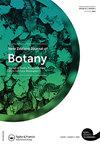新西兰黏菌
IF 1.4
4区 生物学
Q4 PLANT SCIENCES
引用次数: 0
摘要
【摘要】黏菌(也称为黏液胃菌或黏液黏菌)是一组真菌性动物,长期以来被认为是真菌,因为它们产生一些相似(但结构上非常不同)的子实体,并且出现在许多相同类型的生态环境中。最早的6种黏菌是1855年在新西兰发现的,但这些记录所依据的标本是在十多年前收集的。由于黏菌长期以来被认为是真菌,早期的记录在清单和出版的作品中出现了不同的后一类生物。在19世纪下半叶和整个20世纪,关于新西兰黏菌的信息有所增加,1992年出版了第一个相对完整的清单,作者第一次到该国收集。所有粘菌的早期记录都是基于在自然条件下在野外发展的标本,但清单也包括基于湿室培养获得的标本的第一次记录。2003年出版了一本全面而详细的专著(题为《新西兰黏菌》,由真菌多样性出版社出版),其中包括当时在新西兰已知的大约185种黏菌。在过去的二十年里,又增加了一些新的物种。由于黏菌对大多数人来说仍然是不熟悉的生物,因此提供了有关其生物学,其相对复杂的生命周期和自然界生态分布的信息。关键词:生态学;分布;子实体;历史;生命周期;湿室培养;我要感谢所有帮助我在新西兰进行收集工作的人。我要特别感谢我的妻子,她是我多次到全国各地访问时的忠实伴侣。Clive Shirley提供了本文中使用的一些图像,Carlos Rojas准备了用于图6的地图。披露声明作者未报告潜在的利益冲突。我在新西兰的实地工作得到了国家科学基金会和国家地理学会的资助。本文章由计算机程序翻译,如有差异,请以英文原文为准。
New Zealand myxomycetes
ABSTRACTThe myxomycetes (also called myxogastrids or plasmodial slime moulds) are a group of eumycetozoans long thought to be fungi because they produce somewhat similar (but structurally very different) fruiting bodies and occur in many of the same types of ecological situations. The first six species of myxomycetes were reported from New Zealand in 1855, but the specimens upon which these records were based had been collected more than a decade earlier. Since myxomycetes were long regarded as fungi, early records variably appeared on lists and in published works for the latter group of organisms. During the second half of the nineteenth century and the entire twentieth century, information on New Zealand myxomycetes has increased, with 1992 marking publication of first relatively complete checklist and the author’s first collecting trip to the country. All earlier records of myxomycetes were based on specimens that had developed in the field under natural conditions, but the checklist also included the first records based on specimens obtained from moist chamber cultures. A comprehensive and detailed monograph (entitled Myxomycetes of New Zealand and published by Fungal Diversity Press) of the approximately 185 species then known from New Zealand was published in 2003. A number of additional species have been added to this total during the past twenty years. Because myxomycetes remain unfamiliar organisms to most people, information is provided on their biology, their relatively complex life cycle, and ecological distribution in nature.KEYWORDS: Ecology; distribution; fruiting body; history; life cycle; moist chamber cultures; slime moulds AcknowledgementsI wish to thank all of the people who assisted in the collecting I carried out in New Zealand. Special appreciation is extended to my wife, who my constant companion on many of my visits to various regions of the country. Clive Shirley contributed some of the images used in this paper and Carlos Rojas prepared the map used for Figure 6.Disclosure statementNo potential conflict of interest was reported by the author(s).Additional informationFundingMy field work in New Zealand was supported by grants from the National Science Foundation and the National Geographic Society.
求助全文
通过发布文献求助,成功后即可免费获取论文全文。
去求助
来源期刊

New Zealand Journal of Botany
生物-植物科学
CiteScore
2.20
自引率
22.20%
发文量
27
审稿时长
>12 weeks
期刊介绍:
The New Zealand Journal of Botany publishes original research papers, review papers, perspectives, short communications, forum articles, letter and book reviews. We welcome submissions relevant to all aspects of the botany, mycology, and phycology of the South Pacific, Australia, South America, and Southern Africa. The journal’s subject matter encompasses biosystematics and biogeography, ecology, physiology, biochemistry, genetics, reproductive biology, structure and development, taxonomy, ethnobotany, palaeobotany, bryology, lichenology, mycology, plant pathology, and phycology.
 求助内容:
求助内容: 应助结果提醒方式:
应助结果提醒方式:


